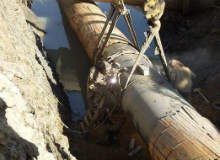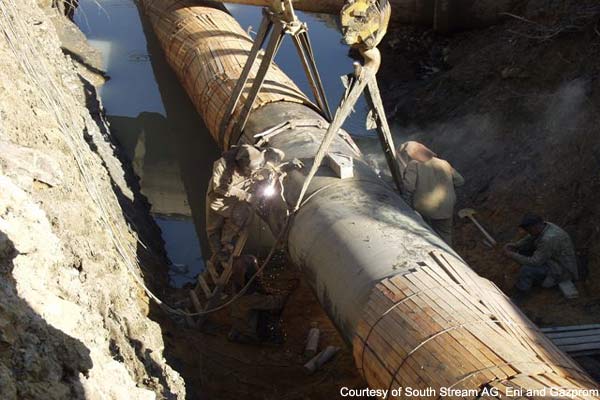

The South Stream gas pipeline project was proposed to transport Russian natural gas across Europe via Bulgaria to Italy.
It was intended to be a direct competitor to the planned extension of the existing Blue Stream pipeline, which runs from Turkey across Europe through Bulgaria and Romania to Hungary.
Construction of the Russian section of the pipeline started in December 2012, near Anapa at the Krasnodar Territory, while construction of the Bulgarian section started in October 2013.
The South Stream pipeline was being built by Russian company Gazprom and Italy-based Eni and was expected to be fully operational by late 2015.
The cost of the proposed pipeline was estimated at €15.5bn.
However, the developers announced the cancellation of the South Stream Project in December 2014 due to objections from the European Union (EU).
South Stream would have been a strong rival to the Nabucco pipeline for competitive supplies.
The South Stream Project was replaced with the Turkish Stream Pipeline project in 2015.
A part of the pipeline will follow the same corridor as the South Stream pipeline, while the remaining part will comprise a new route towards Turkey.
South Stream Project background
Gazprom signed bilateral agreements with major international companies such as Serbian Srbijagas, Hungarian Development Bank (MFB), Bulgarian Energy Holding, DESFA and Austrian OMV to implement the project.
Four joint project companies were formed to implement the project in Serbia, Hungary, Greece and Bulgaria, including South Stream Hungary (Gazprom: 50%, MFB: 50%), South Stream Greece (Gazprom: 50%, DESFA: 50%) and South Stream Bulgaria (Gazprom: 50%, Bulgarian Energy Holding: 50%) respectively.
South Stream pipeline route
For the offshore section, the South Stream pipeline was designed to cross the Black Sea from the the starting point of the Blue Stream pipeline on the Russian coast of Beregovaya, where a compressor station is situated, to the Bulgarian coast at Varna via a 900km (560mi) pipeline, reaching a maximum water depth of 2,000m.
Wintershall Holding was contracted to construct the offshore section of the pipeline.
Two different routes were studied for the onshore section, journeying north-west and south-west respectively.
The south-western route was designed to pass from the coastal town of Varna through Greece and the Ionian Sea to southern Italy. This route could have also supplied the Turkey-Greece-Italy pipeline.
The north-western route was designed to run to the northern region of Italy with an additional branch line to Austria.
South Stream pipeline development timeline
The project to construct the new South Stream pipeline was announced in June 2007, following the signing of a strategic agreement to build the network by Eni and Gazprom in November 2006.
A joint venture company named South Stream AG was set up in January 2008 to construct and operate the pipeline.
Gazprom and Eni each held 50% ownership in the development. South Stream AG was incorporated in Zug, Switzerland, with a share capital of SFr100,000.
A memorandum of understanding (MoU) was signed in November 2007 for the construction of the new pipeline.
The project’s feasibility and marketing studies were completed in 2012 by Saipem, a subsidiary of Eni.
A feasibility study for the Romanian section of the project was completed by Transgaz and Gazprom in November 2010.
The final investment decision for the project was taken in October 2012.
South Stream branches and territory
Branches of the pipeline were designed to have separate agreements. Russia and Bulgaria signed an agreement in January 2008 for the construction and operation of the pipeline in Bulgarian territory.
An agreement between Serbia (Srbijagas) and Russia was signed in December 2006 prior to the announcement of South Stream to study the possibilities of a pipeline from Bulgaria via Serbia and Croatia to Italy.
Russia and Serbia agreed the route of the South Stream pipeline through Serbia in January 2008, and in February 2008 a joint venture company was formed to build and operate the Serbian section to supply ten billion cubic metres (bcm) of gas a year.
Additionally, Hungary and Russia set up a company to support the construction of the pipeline in February 2008.
A government-level meeting between Russia and Italy with Gazprom and ENI was held in 2008 to outline the schedule for reaching agreements with transit countries along the gas pipeline’s route.
Aims of South Stream gas pipeline
The proposed pipeline was expected to carry around 63bcm of gas a year.
The sections through Serbia and Hungary were designed to feature a capacity of at least 10bcm per year.
EDF Group signed an MoU to participate in the Eni-Gazprom joint venture project in June 2010 and was expected to have a stake of approximately 10%.
Gaz de France had also been in negotiation to join the project.
The construction for the Serbian section of the pipeline was expected to start by the end of 2013.
A 540km linear section of the pipeline and 366km of loop lines were planned to be constructed in Bulgaria, in addition to three compressor stations.
Russia signed a contract with Serbia in March 2013 to supply the country with up to 1.5bcm of gas per year for the next ten years.
The South Stream gas pipeline was planned to be used for this supply upon completion.
Related content
Yamal LNG Project, Sabetta, Russian Federation
Yamal liquefied natural gas (LNG) project includes the development of the South Tambey (Tambeyskoye) gas field, located near Sabetta in the Yamal peninsula in Russia.
Fos Cavaou LNG Terminal, Fos-sur-Mer, France
Fos Cavaou liquefied natural gas (LNG) terminal is located at Fos-sur-Mer near the Cavaou peninsula in southern France.


